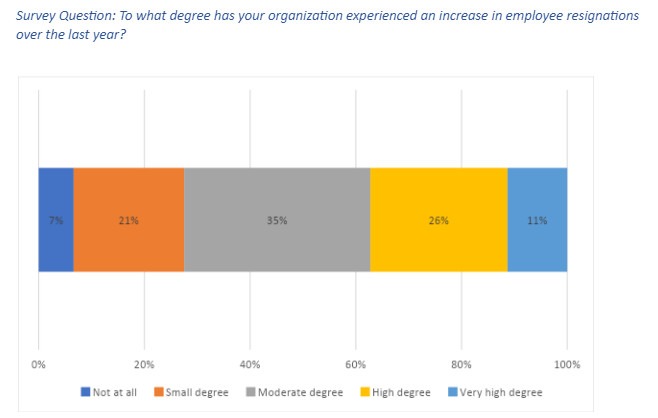It likely comes as no surprise that survey respondents would tell us that they have been experiencing higher than average increases in resignations over the past year. It’s an era that has been dubbed “The Great Resignation,” with Society for Human Resource Management’s (SHRM) president and CEO Johnny C. Taylor, Jr., referring to it as the “Turnover Tsunami.”
It’s a major issue with the potential for major impacts. As Taylor said: “I really am not being hyperbolic when I say that , as CEOs, this is the challenge of our time.”
The Great Resignation
The Great Resignation refers to the massive outflow of employees during the COVID-19 pandemic as employees have reevaluated their needs and desires, prompting them to resign from their current jobs to change career paths. This may include taking a job at a different company, starting their own businesses—or leaving the workforce entirely.
Despite the impact of the pandemic, though, some are pointing out that this issue was emerging even before the pandemic. In a Harvard Business Review article from earlier this year by Joseph Fuller and William Kerr report that while COVID-19 “spurred on” the resignation trend, it is really a “continuation of a trend of rising quit rates that began more than a decade ago.”
No industry is immune and companies of all sizes are experiencing challenges keeping employees on board—and recruiting new employees to fill empty positions. It is, though, according to our respondents, an issue that is more acute in hourly and professional jobs than in managerial positions.
Impact on Companies of All Kinds
Our respondents told us that not only have they experienced an increase in employee resignations to a high or very high degree over the past year (37%), but that it has become a little or much harder to retain employees (87%). Only 28% of our respondents say they’ve experienced a rise in resignations to a small degree or not at all.

Some types of positions are being more impacted than others.
Turnover Across Types of Roles
While hourly and entry-level workers are most likely to jump ship (38% and 32% respectively), professional workers don’t lag far behind at 35%. Some roles we found are less likely to leave—clerical (16%), managerial (13%) and tradespeople (10%).
A challenge for employers is that, given the wide range in employees’ reasons for resignations, there is no “one size fits all” solution to the problem.
Each company and, in fact, even each department or division within individual companies, will likely find variance in terms of both levels of resignations and the reasons employees are deciding to leave their jobs.
What can be done to stem the exodus? That’s a question that is top of mind for employers these days as they seek ways to reduce turnover and keep employees on board.
In our next post we take a look at our second major finding: organizations are gathering data to better understand why employees leave—learn what tops the list!



